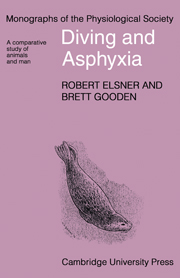4 - Human divers
Published online by Cambridge University Press: 18 May 2010
Summary
In the type of free dives employed by the Ama the engineering problems appear to be rather simple, and involve chiefly the method of getting the diver up and down quickly so that the time on the bottom can be as long as possible. Moşt of the problems, however, will always be physiological, and they deal with human responses at the very margin of tolerance limits. It is, therefore, a fascinating situation that merits thorough investigation
(Wallace Fenn, 1965).Historical background
Early man was a nomadic food gatherer. He took advantage of almost any available food source and this included sea food. At a recent excavation of a Homo erectus site at Terra Amata on an ancient Mediterranean seashore archaeologists uncovered the shells of oysters, mussels and limpets as well as fish-bones (de Lumley, 1969). These remains show that the ancestors of modern man were using the sea as a source of food more than 40000 years ago. Some shells found in prehistoric middens are of varieties that grow in relatively deep water, and this suggests that they were collected during breath-hold diving (Nukada, 1965).
Initially, diving was probably performed to supplement other food supplies. As time passed sea food became increasingly important as an item of trade with other groups. Products such as pearls and sponges were sought for reasons other than nutrition. The abalone were used in Japan for aesthetic as well as religious purposes.
- Type
- Chapter
- Information
- Diving and AsphyxiaA Comparative Study of Animals and Man, pp. 60 - 73Publisher: Cambridge University PressPrint publication year: 1983
- 1
- Cited by



